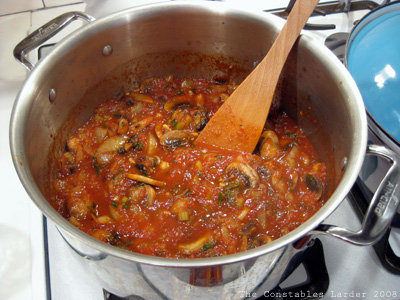
A few months ago, some friends of ours from Harrison, NY, gave us a jar of homemade stewed tomatoes. Apparently every year, a group of Italian women in the neighborhood (our friend’s mother being one) buy a huge quantity of tomatoes, mill them to de-seed and de-skin, stew, and then preserve in sterilized glass jars with a sprig of basil. Note: I’m hoping to get a more detailed description of this process to post in the next day or so (Update: description posted here).
On Monday evening we decided to crack open the jar and taste. I can only describe my taste bud reaction as “holy moly!” It had to be the sweetest tomato flavor I’ve ever had. Well, after this moment, my goal could only be to use this as the base for a pasta sauce without distracting too much from the incredible core flavor.
1 jar of stewed tomatoes (see below)
1 vidallia onion, chopped
1 and a half stalks of celery, chopped
2 cloves of garlic
8 oz white button mushrooms, cleaned and sliced
handful of parsley, washed and chopped
virgin olive oil
salt and pepper
I started by heating some olive oil in a big pot on low heat, and then sauteing the onions and garlic until the onions started to turn translucent. I then added the mushrooms and sauted, stirring occasionally, until the mushrooms were cooked and exuding their juices. I tossed in the parsley and celery, a pinch of salt and some ground pepper (I kept the salt light because the natural flavor of the tomatoes was so good), and let cook for a couple more minutes.
Normally I would also add wine or vermouth at this stage but it just wasn’t needed here. I then added the tomatos, turned up the heat slightly to bring everything to a light simmer, and cooked for about 30-60 minutes stirring regularly. We served this with farfalle pasta (campanelle would have worked nicely too) and a d’Arenberg Footbolt Shiraz.
Now, the tomato sauce we used as a base is obviously not something you can run out and get. Normally I use tins of peeled Italian tomatoes, and to be honest I rarely take the step to deseed the tomatoes (usually due to time considerations). Jamie Oliver also tends to leave the seeds in, and takes the approach of letting the tomatoes cook whole (i.e. he does not cut or break them up) with the sauce for a while and only breaking them up and letting the seeds out into the mix near the very end.
Many cookbooks talk about how tomato seeds can add slight bitterness. I had never really felt this to be enough of a problem to take the time, but if you want to try working with canned, peeled Italian tomatoes without the seeds, it’s a relatively easy, if slightly messy, step. To preserve most of the juices, I recommend working in your sink with a strainer over a bowl. Take each tomato, break it open in the middle with your fingers (they will be very soft), and let the seeds run out, gently scooping out any recalcitrant ones. Let the juices flow into the bowl, save the tomato flesh (can just put in the same bowl), and toss out the seeds in the strainer.
What a treat! Canning is a process that I hope to master someday soon so that I can do the same with my homegrown tomatoes.